|
|

The FastPAD products are high-powered, multi-protocol switches that may be used in FRAD or switching applications. The FastPAD comes in several different "flavors" with varying numbers of processors and ports.
There are stand-alone products and shelf systems.
FastPAD products use CMS technology and are designed around two or four MC 68302 microprocessors. The boot and operating system are stored on PROM FLASH SIMMs. Configuration is stored on EEPROM. There are up to 4 MB FLASH PROM and DRAM SIMM. The FastPADs use a new high-capacity connector (FutureBus) that provides a flexible interface interconnection system.
Many features are governed by user's rights stored on the SmartCard or on battery-protected RAM. Transputer technology allows a modular system with matrix architecture where the user can add modules in parallel to increase processor power, connectivity and switching.
The FastPAD family consists of five products:
Each product is targeted to meet specific network needs and plays an important role in the Cisco WAN access strategy. This publication describes the FastPADmp, mp6, mp12, mpr12 and mpr24.
The products, mp, mp12, and mprxx all operate with the same software, while the mp6 needs its own specific software. All the products have many similar features and support a wide variety of protocols:
Specific features such as Dynamic Line Management (DLM), Secured Virtual Circuit (SVC), Stac Data Compression, encryption, and SNMP are also available. Protocols and capabilities are all available over PSTN, ISDN, PDN and Frame-relay network.
The FastPADmp products have configurable line interfaces which may be configured as trunks or ports. Of the multiple lines available on each module, at least one line must be configured as a trunk, but multiple trunks are possible on each of the products.
The FastPADmp products use a high-capacity connector (FutureBus connector) system that enables many different connections to be present on the same module. Interfaces such as V.24/V.28, V.11, V.35, X.24, X.21 and X.21bis may co-exist on the same product. Also available are ISDN Terminal Adapters and G.703 Adapters.
The FastPADmp6 is the smallest of the multiprotocol products. It is a single-board device (one motherboard, no daughterboard), designed for use as an inexpensive concentrator at branch office banking sites. It is designed to be stand-alone but can be rack-mounted (up to six mp6) if required, and in that case, each mp6 works as a single node. It can connect up to six multi-protocol lines, each line can be configured independently with any protocol available among the standard software, and handles speeds up to T1.
The FastPADmp6 offers three low-speed data ports (V.24/V.28), two high-speed data ports (V.24/V.28 or V.11), and one multi-purpose, high-speed trunk port.
The FastPADmp is a two-board device (motherboard and daughterboard) designed for use as remote multi-protocol concentrator. This product comes in stand-alone mode but can be rack-mounted. Up to three mps can be housed within a rack, each working as a single node. The FastPADmp is a moderately powered module with twelve physical lines that may be configured with any of the interfaces already mentioned above, and handles speeds up to T1.
The FastPADmp12 has the same hardware structure as the mp (motherboard and daughterboard), but is a more powerful device. The FastPADmp12 is in fact, the highest powered device in the product line (higher clock frequency and use of the transputer). It is designed as a backbone node or a front-end communication processor.
This product comes in a stand-alone or shelf system. Like the mp, up to three mp12's can be housed in a rack. However, unlike the mp, because of transputer technology used, the three mp12s work as a single node called a logical unit. The mp12 handles twelve physical lines, any of the interfaces mentioned above, and speeds up to E1.
The transputer allows network managers to easily scale up there network as requirements grow.
The FastPAD mprxx is the redundant version of the mp12, especially designed for backbone nodes requiring very high reliability. It is based on the same hardware as the mp12, combined with an internal switch matrix system allowing 1-1 or 1-2 redundancy.
There are two types of mpr:
In the event of a module failure, the FastPADmpr automatically switches connections from failed modules to working modules. Hardware-wise the FastPADmpr12 and mpr24 are the same, except that the mpr12 is configured with two modules and two YB Boards and the mpr24 is configured with three modules and four YB Boards. The FastPADmprxx is only available in a rack-mount configuration.
Table 1-1 summarizes the configurations of the five platforms. A single FastPADmp, mp6, or mp12 is referred to as a "module." A group of three mp or mp12 modules is referred to as a "unit." (However, note that a FastPADmp can not be a logical unit, only a physical unit.)
| Platform | Stand-alone | VLSI Rack | 1 Logical Unit |
|---|---|---|---|
mp6 | Y | Y | N |
mp | Y | Y | N |
mp12 | Y | Y | Y |
mpr12 | N | Y | Y |
mpr24 | N | Y | Y |
The FastPADmp products may be used either as a FRAD or switch in any of the following applications.
In a typical branch application the FastPADmp and FastPADmp6 handle SNA, BSC, and X.25 PAD. Frame relay traffic, from Token Ring or Ethernet routers, may be consolidated onto a single trunk circuit to the frame relay network.
The FastPADmp12 and FastPADmpr are X.25/frame relay switches designed as high- performance points for X.25 services. For instance, an enterprise network with existing X.25, Async, SNA, and BSC traffic could use the FastPADmp12 or FastPADmpr to groom the traffic into frame relay before placing it on the IGX backbone. Because of the high FastPADmp12 port density, other ports on the IGX can now be released for voice, video, and data connections.
To provide native X.25 services, carriers can deploy the FastPADmpr at their local central offices as a feeder to their Cisco IGX/BPX backbone network. Carriers can provide for their customer's connections and have integrated network management from equipment supplied by one vendor.
Some carriers may choose to deploy the FastPADmpr at the customer site.
The FastPADmp12 or FastPADmpr may also be used as local, high-performance frame relay feeder switches for large router networks. The user can consolidate multiple frame relay links into one high speed link from their service provider.
Today, when a customer needs X.25-to-frame relay services, the FastPAD multiprotocol products can serve that need. In the future, when the customer's X.25 ports become frame relay ports, the FastPAD multiprotocol products are easily reconfigured to be frame relay switches.
An operating software has all functionalities. To use a specific feature, you need to subscribe to the correct license. User Rights define the maximum number of lines, protocols supported and features. These rights are purchased at the time of order and have the codes listed in Table 1-2.
| User Right | Control | Code |
|---|---|---|
Version Maximum | Static | VXX |
Number of Lines | Static | 0XXL |
Number of X.25 Lines | Static | XPLS |
Number of MLP Bundles | Static | XMLP |
Number of Asynchronous Lines | Static | ASY |
Number of VIP Lines | Static | VIP |
Number of SDLC Lines | Static | SDLC |
Number of BSC3270 Lines | Static | BSC |
Number of BSC27/3780 Lines | Static | BSC2 |
Number of ISDN B Channels | Static | CBAS |
Number of ISDN D Channels | Static | CD |
IP Routing and SNMP | Static | CLAN |
Number of HDLC-T Lines | Static | TRAN |
Number of Rerouting Lines | Static | RER |
Number of Frame Relay Access Lines (FRA) | Static | FRAD |
Number of Frame Relay Lines (FRI, FRSW) | Static | FRN |
Number of Frame Relay Lines for SNA | Static | FRSNA |
Number of Frame Relay Lines for IP | Static | FRIP |
Number of Frame Relay Lines for Transparent | Static | FRT |
Redundant Rack | Static | SEC |
Number of Redundant Virtual Circuits Lines | Static | VCS |
Compression LZ78 | Dynamic | LZ78 |
Extended Statistics | Static | STSC |
Dynamic Line Management (DLM) | Static | SD |
Number of BSC-T Lines | Static | BSCT |
On-line Down-loading | Dynamic | TCOL |
Number of X.75 Lines | Static | X75 |
Number of Videotext Access Points | Static | PAVI |
Compression LZ77 | Dynamic | LZ77 |
Number of X.28 PLUS | Static | X28P |
Packet on ISDN Channel |
| PAQD |
Number of Multistandard PAD Connections | Static | PADM |
Management Access Point |
| PAE |
The mp6 user rights are stored on battery-protected RAM since the mp6 does not employ the SmartCard.
The mp, mp12 and mprxx use a PCMCIA SmartCard. The licenses can be found on the label attached to the bottom of the SmartCard. The Smartcard also can store operating configuration. If a FastPAD module fails, the user can move the Smartcard to a new module and load the original configuration instantly. The result is quick network replacement and less network downtime.
The SmartCard contains the user rights for software operation. You must insert the card in the SmartCard slot for the FastPAD to function. Insert the SmartCard into the FastPAD front panel opening before powering on the unit. (See Figure 1-1.)
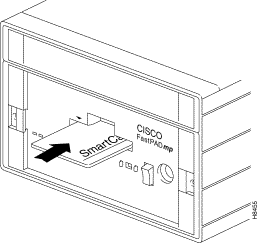
 | Caution If the SmartCard is removed, the FastPAD will continue to operate for 25 seconds; after which it goes into an idle state with the default configuration. |
 | Caution When handling the Smartcard, take precautions against electrostatic discharge. If no other method is available, touch the ground screw on the module's rear panel before handling. The Smartcard contains a lithium battery which will run up to 10 years. To protect your warranty and for safety, it should be replaced by an authorized technician. |
This port is not able to receive calls but can be used to generate calls to any device within the network.
On an asynchronous terminal or PC connected to the front panel DIN connector, the user must enter a carriage return and then receive a * prompt, indicating that the FastPAD is ready for use.
For all the FastPAD devices, the processor board is attached to the front panel. To access the processor board:
Step 2 Press the catches outward and pull the front panel forward.
Figure 1-2 illustrates how to remove the processor board of an mp.
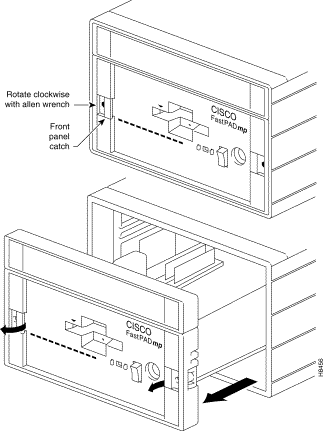
To install FLASH and DRAM SIMMs, proceed as follows:
Step 2 Keeping the chip at an angle, use both hands to press it into the connector until it is fully inserted.
Step 3 Then, still holding both sides of the chip, press it carefully in the direction of the arrows until it locks into place with a snap.
To remove SIMMs, follow these steps in reverse order.
The FastPAD may be used with six different interface cards including V.28, V.11, V.35, TTL as well as the G.703 board and ISDN interface card (IFSO).
These small cards plug into connectors located at the rear of the Main Processing Board. According to the side by which they are inserted into the motherboard, these cards offer a DTE or DCE interface on the back panel. It is possible to connect modems as well as terminals to the FastPAD with standard cables.
Each card is an electrical interface. Thus the type (V.28 etc.) and gender (DTE, DCE) on the line interface can be chosen independently for each line. The available interfaces are:
For more details about interface cards, refer to the chapter "Interface Cards."
A grounded power source must be used. See the appendix "Specifications" for power specifications for AC and DC models.
The Universal/Redundant shelf and FastPADmp/mpr modules are respectively protected by a fuse on the front panel of the rack power supply or on the power supply at the rear of the "core." Before replacing the fuse, assure that the shelf is disconnected from the power source.
For the 48V DC model, connect the shelf to a 48V DC source that is electrically isolated from the AC source.
When properly connected to a power source, grounding is accomplished via the power cord. Use only a 3-prong grounded power source.
A screw connector is provided on the rear panel above the power supply for additional grounding if required.
 | Warning Before connecting the equipment to a power source, make sure the power switch is off, and that the local power source matches device power specifications listed on the rear panel. |
An asynchronous terminal or PC in terminal emulation mode may always be connected to the FastPADmp's front panel DIN connector or to the port five (12 modulo) on the rear panel when it is in default configuration.
In the default configuration, line 5 (modulo 12) of the FastPAD is set up for supervisory access. The data format is 8 data bits, no parity, and the speed is "autobaud", automatically detecting terminal speeds up to 19.2K bps.
From line 5, enter several returns (or <CR> or H) to activate autobaud, and you should receive an identification banner and a menu of selections.
Installing the shelf into a cabinet is illustrated in Figure 1-3.
If you mount several shelves, leave one U between each shelf.
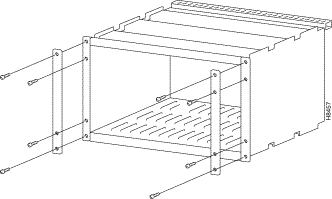
When the shelf is housed in the cabinet, insert the power supply as shown in Figure 1-4.
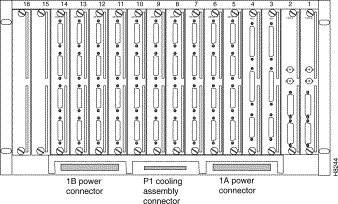
Refer to the corresponding chapter according to the type of device you are setting up
(mp 12, mpr). The following illustration shows a shelf with one mp12 module (Module 0) inserted.
The following points apply when installing FastPADmp12 or FastPADmpr units in a Universal or Redundant Shelf:
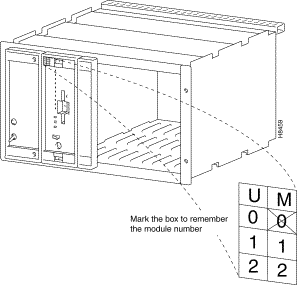
For unused shelf slots, a blank plate must be assembled. Figure 1-6 shows the assembly of vertical cover bars, locking rail, and plates.
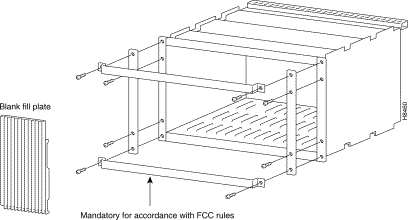
![]()
![]()
![]()
![]()
![]()
![]()
![]()
![]()
Posted: Thu Jan 25 14:11:44 PST 2001
All contents are Copyright © 1992--2001 Cisco Systems, Inc. All rights reserved.
Important Notices and Privacy Statement.